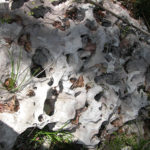
Memory
Alligator Attack on the Ichetucknee
by Geoff Pitts
| FOR VARIOUS REASONS related to poor academic performance and the draft, I found myself at The Eastern Shore Branch of the University of Virginia near Chincoteague in the late sixties. This small school of about 125 students was ensconced in some abandoned Army apartments—the offices, the classrooms, and both the faculty housing and the student dorms were all in the same identical buildings. This set up, plus the remoteness of the Eastern Shore, encouraged student/teacher socializing and friendships.
Despite the fact that I didn’t read any of the novels he assigned, my Advanced English teacher, Carl Furlow, and I became dear friends. I eventually returned to Charlottesville and he went home to Florida but after my wife, Judi, and I got together we drove down to visit a number of times and the two of them became devoted friends also.
Carl and his friends lived just a few miles from the most beautiful water I’ve ever seen: Ichetucknee Springs.
Geoff Pitts sent this memory from his home in Barboursville, Virginia.
Carl lived in the remote, flat, sandy farmland of northern Florida near Fort White. On our first visit he introduced us to his neighbors, Loye and Barney Barnard. Depending on what year it was, they were either dry cleaners or stained glass artisans or owned an Italian restaurant or installed solar panels or grew aloe or ran an Eco Tourist B&B in the islands. Loye is a wonderful water colorist and a lifelong environmental activist. Barney is a master of most trades and way too fond of terrible puns. We fell in love with them soon after Carl introduced us.
In about 1976, Judi and I and our two little girls made the long drive down to northern Florida in our secondhand Pinto station wagon for a stay of 5-6 days with Carl. He and his friends lived just a few miles from the most beautiful water I’ve ever seen: Ichetucknee Springs. The Head Spring and the Blue Hole are both dramatic and lovely. Clear, clean water gushes from the white sand, forming pools around each spring and then they join to make the Ichetucknee River. Snorkeling in the limpid water of the springs, we found small turtles with big, triangular heads, fresh water flukes (like flounder) the size of your hand that were sand colored on top and pale underneath, and on one occasion a petrified camel’s tooth. The Blue Hole is a 12-foot diameter shaft that leads to an underwater cavern system that can be explored with scuba gear. The volume of water rushing out of the Blue Hole is reported to be 60 million gallons per day—the surface of the pool directly above the spring looks like it’s boiling. The spring pools are ringed with eelgrass and overhung with cypress and descriptions of this magical place almost always use words like “gorgeous” and “primeval.”
We spent one of our days floating down from Ichetucknee Springs to its confluence with the Santa Fe River. Judi and 3-year-old Caitlin were in one small, inflatable raft, first-grader Becca and I shared another, and Loye and one of her friends accompanied us in a canoe. We drifted leisurely through this southern lowland, borne on the glassy clarity of the stream, chatting, pointing out trees and birds and wondering at these lush, tropical surroundings.
Eventually one of us had to pee and it turned out to be me. I started looking around for somewhere to get out of the raft without toppling Becca into the water. There was no place—there were no rocks, no logs, no beaches. We were surrounded by swampy, snake-infested grass. I searched and waited and searched and finally did what anybody would have done—I just peed where I sat—no big deal.
We were wet and there was already water in the bottom of the raft but that didn’t keep my fastidious daughter from pitching a fit (I would have had no trouble if she had peed). She complained loudly and at length.
About 15 minutes later, as we drifted in the urine, I looked up and saw a large alligator on top of a steep bank, huge toothy mouth wide open. Just as I was pointing this creature out to everyone, she (rangers later said she was a mom gator) closed her mouth and shot forward, off the bank and into the water directly below both of our thin, skimpy, made-in-China toy boats. In panic and desperation I started screaming, “Paddle! Paddle! Paddle!” How was I supposed to save my entire family from this rabid carnivore separated from my perineum by 8 mils of cheap plastic? About 10 minutes later and 10 miles downstream, I started to begin to relax. It appeared that we had survived The Alligator Attack and what was even better, the excitement had finally caused Becca to forget that she was sitting in a puddle of pee.
Back in Charlottesville, Becca stood up for first grade show-and-tell and told the class that on vacation, her Dad had been scared by an alligator and peed in the raft Becca was sitting in.
Life can be so unfair.
